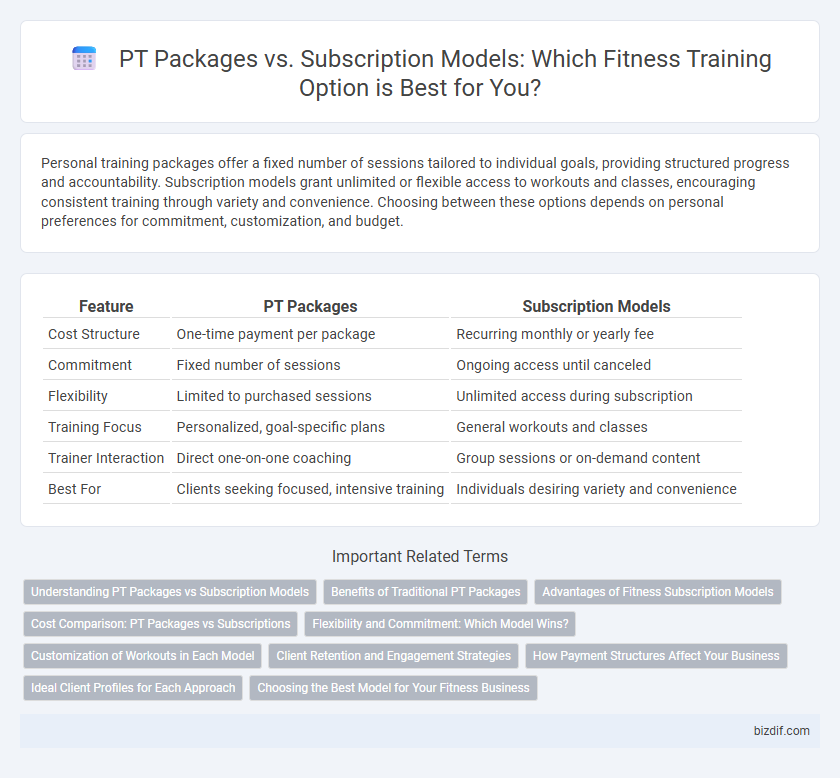Personal training packages offer a fixed number of sessions tailored to individual goals, providing structured progress and accountability. Subscription models grant unlimited or flexible access to workouts and classes, encouraging consistent training through variety and convenience. Choosing between these options depends on personal preferences for commitment, customization, and budget.
Table of Comparison
| Feature | PT Packages | Subscription Models |
|---|---|---|
| Cost Structure | One-time payment per package | Recurring monthly or yearly fee |
| Commitment | Fixed number of sessions | Ongoing access until canceled |
| Flexibility | Limited to purchased sessions | Unlimited access during subscription |
| Training Focus | Personalized, goal-specific plans | General workouts and classes |
| Trainer Interaction | Direct one-on-one coaching | Group sessions or on-demand content |
| Best For | Clients seeking focused, intensive training | Individuals desiring variety and convenience |
Understanding PT Packages vs Subscription Models
Personal training (PT) packages typically offer a set number of sessions purchased upfront, providing targeted and personalized fitness guidance with a clear cost structure. Subscription models grant ongoing access to fitness resources, group classes, or virtual training for a monthly fee, offering flexibility and continuous support. Choosing between PT packages and subscriptions depends on individual fitness goals, budget, and preference for personalized attention versus broader access to diverse workouts.
Benefits of Traditional PT Packages
Traditional PT packages offer personalized fitness plans tailored to individual goals, ensuring focused progress and accountability with dedicated one-on-one sessions. Clients benefit from upfront payment structures that often include a set number of sessions, providing clear commitment and motivation. These packages also allow flexible scheduling and the option to pause or customize sessions based on personal needs, enhancing convenience and control over the fitness journey.
Advantages of Fitness Subscription Models
Fitness subscription models offer flexible access to a wide range of workouts, allowing users to tailor their training to personal goals and schedules. These models often include regular updates with new classes, expert guidance, and progress tracking through integrated apps, enhancing motivation and consistency. Cost-effective compared to traditional personal training packages, subscriptions provide scalable options ideal for both beginners and advanced athletes seeking diverse fitness experiences.
Cost Comparison: PT Packages vs Subscriptions
Personal training (PT) packages often require an upfront lump sum payment, offering a fixed number of sessions that can lead to higher costs per session but greater flexibility in scheduling. Subscription models typically involve monthly fees with access to unlimited classes or sessions, which may reduce the average cost per workout for frequent users while creating ongoing expenses. Evaluating the total cost depends on workout frequency and personal goals, as occasional trainees might benefit from PT packages, whereas consistent gym-goers might find subscriptions more cost-effective.
Flexibility and Commitment: Which Model Wins?
Personal Training (PT) packages offer flexible session counts and scheduling, allowing clients to tailor workouts without long-term commitment, ideal for those seeking personalized, sporadic guidance. Subscription models provide consistent access to fitness services, promoting routine and accountability but often require ongoing monthly fees that may limit flexibility. Clients prioritizing adaptability and minimal commitment often prefer PT packages, while those focused on structured progress and continuous motivation benefit more from subscriptions.
Customization of Workouts in Each Model
Personal Training (PT) packages offer highly customized workout plans tailored to individual fitness goals, needs, and progress, with one-on-one attention from certified trainers. Subscription models typically provide flexible access to a variety of workout programs, enabling users to select and adjust routines based on preferences but may lack personalized guidance. The customization in PT packages ensures targeted progression and adaptation, while subscription models emphasize convenience and variety for self-directed fitness at scale.
Client Retention and Engagement Strategies
PT packages offer personalized, goal-oriented sessions that enhance client retention by providing clear progress milestones and tailored feedback. Subscription models encourage consistent engagement through flexible access to a variety of classes and on-demand content, appealing to clients seeking convenience and variety. Combining individualized attention with ongoing accessibility optimizes client loyalty and long-term commitment in fitness training programs.
How Payment Structures Affect Your Business
Personal training packages offer upfront payment, providing immediate cash flow and simplifying revenue forecasting for fitness businesses. Subscription models create recurring income streams, enhancing client retention and long-term financial stability. Choosing the right payment structure influences customer commitment, budgeting predictability, and overall business growth potential.
Ideal Client Profiles for Each Approach
Personal Training (PT) packages appeal to clients who value personalized, goal-specific guidance and prefer defined timeframes for focused progress, such as athletes or individuals recovering from injury. Subscription models attract fitness enthusiasts seeking flexibility, variety, and ongoing motivation, often ideal for busy professionals or those wanting to explore different workout styles without long-term commitment. Both approaches cater to distinct client needs, with PT packages emphasizing targeted coaching and subscriptions offering convenient, scalable fitness access.
Choosing the Best Model for Your Fitness Business
Personal training (PT) packages offer fixed sessions that provide clients with clear goals and costs, enhancing commitment and progress tracking, whereas subscription models ensure steady revenue through ongoing access to fitness services, appealing to those seeking flexibility. Fitness businesses must assess client preferences, cash flow needs, and service variety when selecting between PT packages and subscription plans. Integrating data-driven insights on customer retention and revenue predictability helps optimize profitability and client satisfaction in competitive fitness markets.
PT Packages vs Subscription Models Infographic

 bizdif.com
bizdif.com